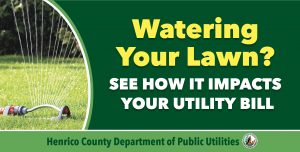Overwatering your lawn can waste water and raise your water bill. To calculate sprinkler usage, average of 5 gallons per minute per sprinkler head, multiplied by the number of sprinkler heads, multiplied by the number of stations. Multiply that number by the number of times your water in a week or month. Example:
- 20 minutes x 5 gallons per minute = 100 gallons for one sprinkler head x 5 sprinkler heads in a station/zone = 500 gallons used per station/zone
- 500 gallons x 6 stations = 3,000 gallons used for one watering
- 3,000 gallons x 3 days per week = 9,000 for one week of watering
- 9,000 gallons x 8 weeks = 72,000 gallons used to water the lawn in a bi-monthly cycle, which is $399.36 on your next utility bill
(Summer Water-Usage Tips. The Colony, Texas, 2019, thecolonytx.gov/DocumentCenter/View/3898/WaterUsageTips2019. Accessed 1 June 2020.)
The increased water use also increases the risk of fertilizer and pesticide runoff from the lawn to paved surfaces and negatively impact water quality.
Overwatered lawns frequently lead to excess blade growth, summer fungal diseases and more frequent mowing.
You can take steps now to reduce your water use and save on your water bill.
Tips for Better Watering
- How can I tell if my lawn needs water? A thirsty lawn initially shows signs of “footprinting.” In these areas, the grass blades will not spring back if you walk across your lawn, and your footprints will be visible. This is the first sign of wilt and indicates a need for water.
- Water is best applied first thing in the morning — a few hours before or just after sunrise — when evaporation loss and the impact from the wind are lowest.
- Water the lawn — not driveways, sidewalks or roads — by adjusting sprinkler heads.
- Mow grass at the right height both before and after summer. Fescue lawns are best mowed at a height of 3”.
- Convert lawn to a more drought tolerate species — Zoysia or Bermuda
- Install a rain-sensor on your irrigation system to shut down automatic systems during/after rain events.
- Additional resources can be located at the Henrico Cooperative Extension — https://henrico.us/extension/





